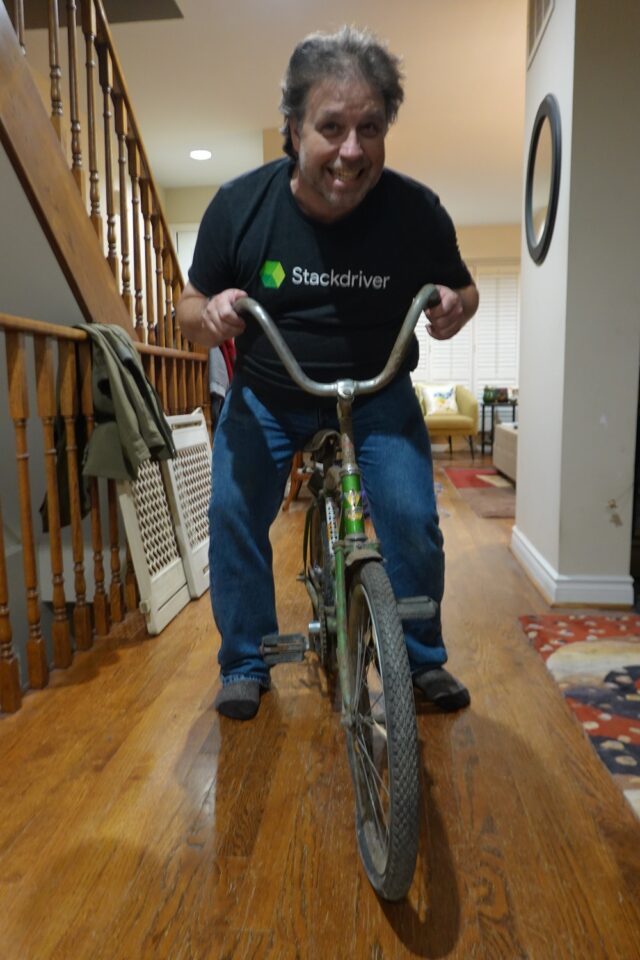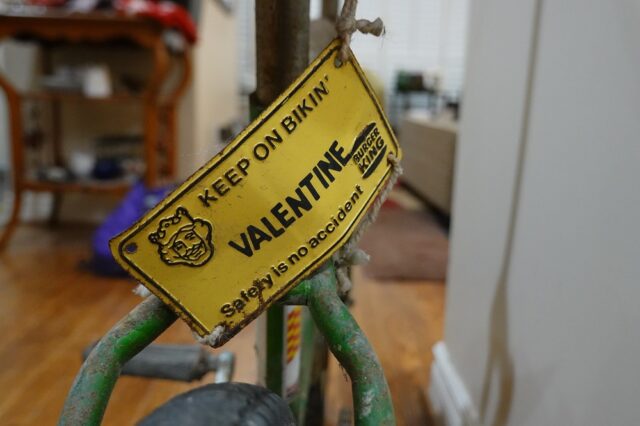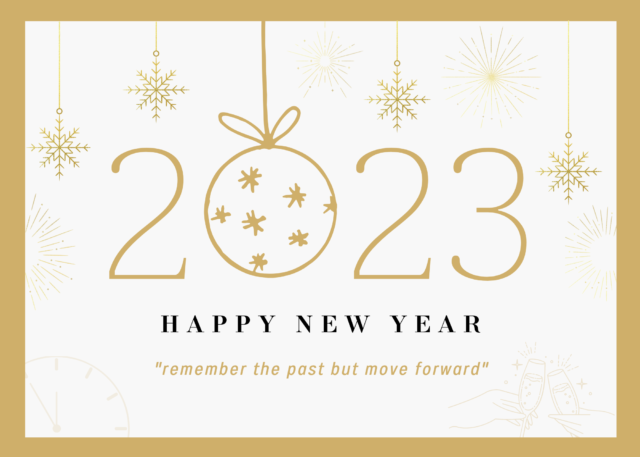
Ms. GAuthor Archives
CHW3M World History Culminating
PD @ York U SWSH Conference, Dec. 13, 2022
https://docs.google.com/presentation/d/1O4_hqBe8vZZvVQZTsZxkB6fwnjlVtE_3TXO4JjPJQ8U/edit?usp=sharing
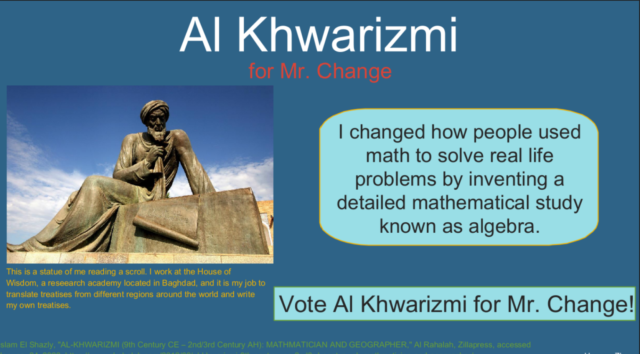
I hope to see you on Feb. 17, 2023 at York Mills CI for the SWSH PD Conference.
I’ll be sharing my grade 11 World History culminating activity.
Last 3 Books
It has been a while since I’ve reported on recently read books. Taking the TTC still allows me lots of time to read, mostly in the mornings when service is more reliable. It’s hard to read standing up on the way home.

Val recommended this book to me after he read it. Val and I don’t always enjoy the same kinds of books, however, we both enjoyed this one.
I had never heard of Elamin Abdelmahmoud even though I’m a CBC person. He’s a CBC host, apparently, but his field is popular culture so I would never have known about him. I’m rather an outsider when it comes to popular culture. His book, in a nutshell, is about immigrating to Canada at a young age from Sudan. The glitch: he moved to Kingston, Ontario, where he came to learn he was seen as Black in Canada. He writes about this with humour and sensitivity. It was a great book for a white person such as me who has had no life experience of having to fit in.
Elamin definitely has an interesting personality. His writing is sweet and quirky and metaphorical. Highway 401, seen on the cover, emerges as the dominant metaphor in his life as he travels up and down, from his restricted life at home in Kingston with his family to his new and more freeing opportunities down the road in Toronto and beyond.
Elamin came to love wrestling, particularly writing fantasy wrestling scenarios. Who had ever heard of this? It got him into writing. He became very methodical about it. And thankfully so for he has written a great gem.

Since I had enjoyed Val’s recommendation of “Son of Elsewhere” so much, I asked him to suggest another book for me as I had nothing lined up. The previous two books I had read were kind of fast moving so I wanted something longer. He went with Daniel Kahneman’s “Thinking Fast and Slow.” Wow, what a different kind of book. Very heavy and academic, but also really well written, funny at times.
The last time I read a book with a section on economics was in a biography of Karl Marx. The chapter on his economic views for Das Kapital put me to sleep. I hardly ever skim over a chapter when reading. This time I made it through an entire 400-page book by an economist – well, he’s actually a psychologist. That’s mostly because he is a very entertaining writer. I loved it when he totally dissed people who pick stocks. It’s just the law of averages, he says. More so than the material, I enjoyed Kahneman’s descriptions of the life of a professor. Interesting life. His wife, it turns out as revealed in the post-script, is also a great writer. She wrote short summaries at the end of each chapter that made the complex psychological concepts much more digestible.
The major theme of the book is that our brain has two systems: one that think quickly and without deep consideration; the other that considers and analyzes. If we can learn more about these systems, we can make better decisions and become more aware of when we’re not making decisions at all. I find a lot of this applicable to my job as a teacher. However, most likely I’ll forget it because it’s so complex. That is the current state of my brain (my memory).

Last year I attended an equity workshop that mentioned this book by Beverly Tatum, originally published in 1997. When I saw this 20th anniversary edition in my local bookstore I jumped at it. And that was not a mistake.
The first chapter, a prologue written in 2017 after the Obama years and just as Trump was elected, was a highly depressing summary of the history of the last 20 years in the US replete with police shootings and entrenched white supremacy.
The premise of this beautifully written, personal and heartfelt book is that all children and teenagers, regardless of race, develop their racial/ethnic/cultural identities in their social contexts, whether that’s in situations where they’re in the majority or the minority.
Even though the book is American, I found it really helpful for prompting me to consider my students’ identity development processes. I sincerely hope that the Canadian context is different the American one, though this may be inherently naïve. Like all equity materials I have read over the past few years, it reminds me that racism is best understood as institutional, systemic.
One resource that Tatum relies on often is comments from students in her past university seminars on racial awareness. I found these the best parts of the book, honestly addressing the challenges of all kinds of students in living in a rapidly changing world. I loved reading their words, first person. Tatum is an optimistic – some might say slightly naïve, person who feels change is possible through hard work and deliberate interactions between people of different backgrounds overcoming their fears, ignorance, and lack of past experience.
This line really got my attention on the subway: “Institutional policies and practices are created and carried out by individuals, and when those individuals have homogeneous social networks, they too often lack empathy for those whose lives are outside their own frame of reference. I believe opening social networks and closing the empathy gap is a step toward bringing about positive change (Tatum, 345-46).”
I don’t have a next book. This one was really hard to top.
A Halloween Ghost Story
On October 29 we went to this kind of spooky house at 60 Salome Drive, near Sheppard and Midland. It’s boarded up and the yard – backing onto the train tracks – is heavily overgrown. It may be the closest thing I’ve ever seen to a haunted house.

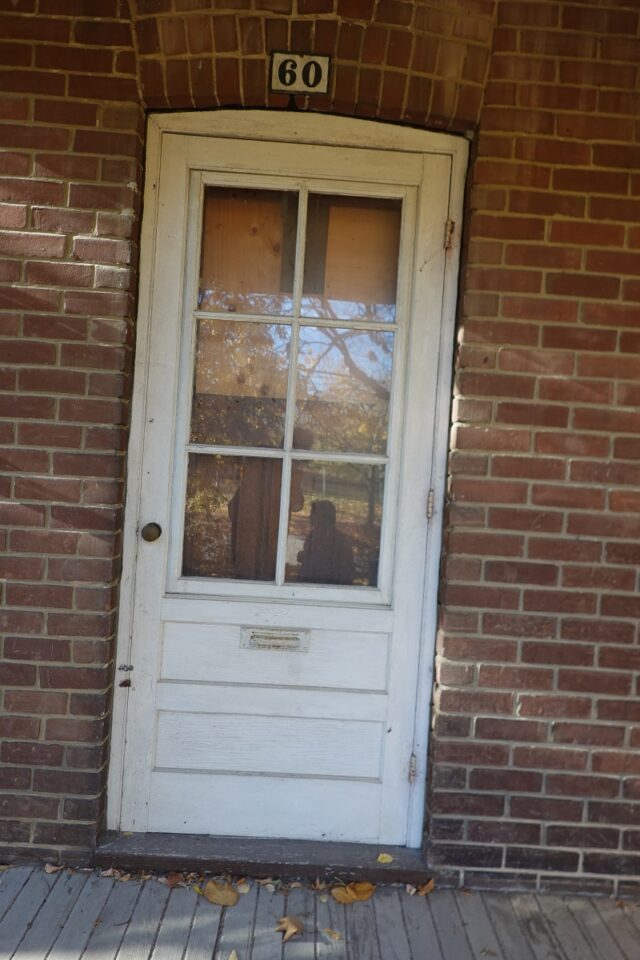
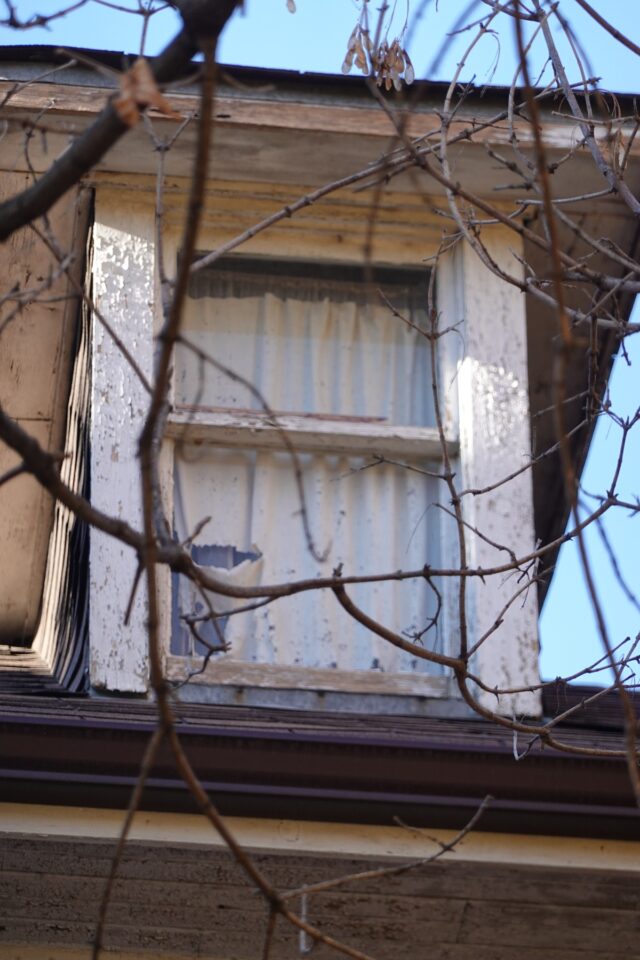
There’s a barn out back. It’s in far worse shape than the house. It has a lot of weird doors. Almost everything is very tightly screwed shut.
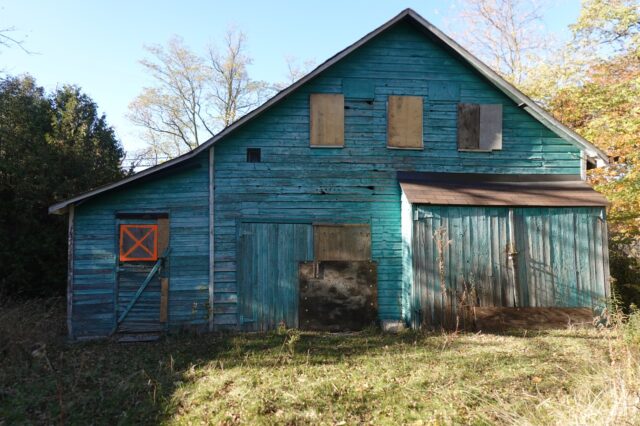
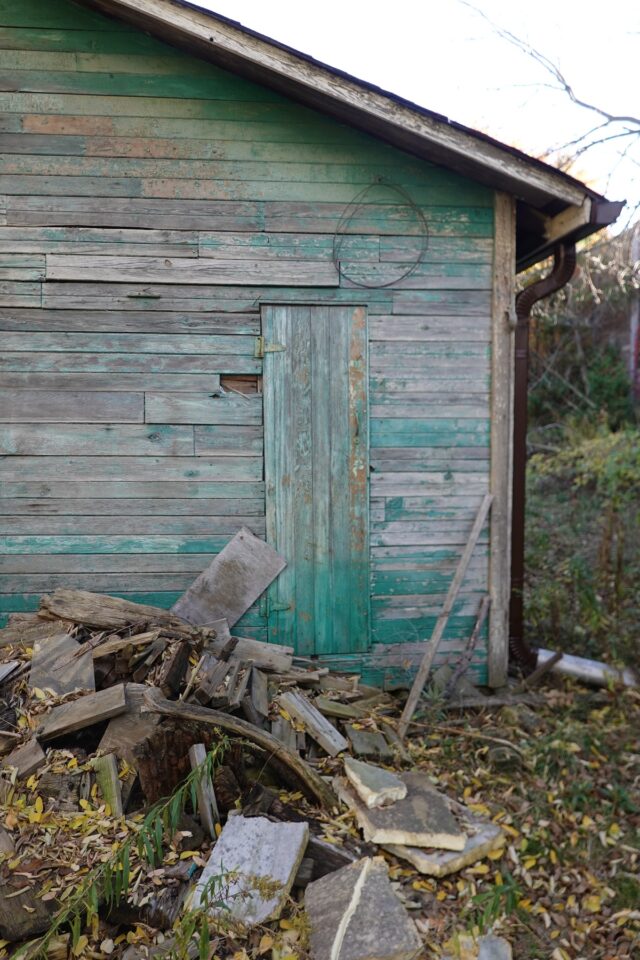
We walked around the mess of a yard, making our way through some tall weeds and prickly plants. Maybe someone was living ‘rough’ there?
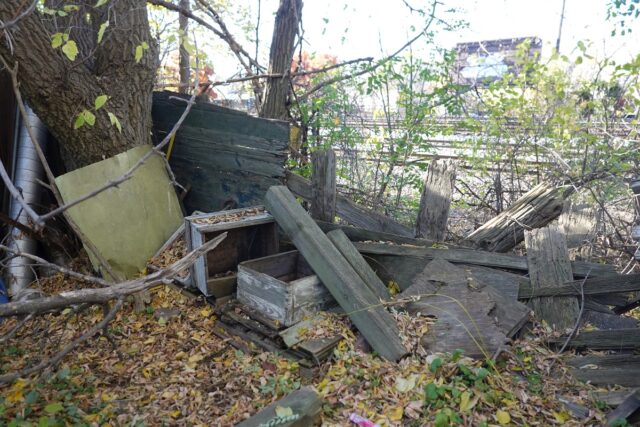
Coming back to the barn, we peaked inside the tiny little window.
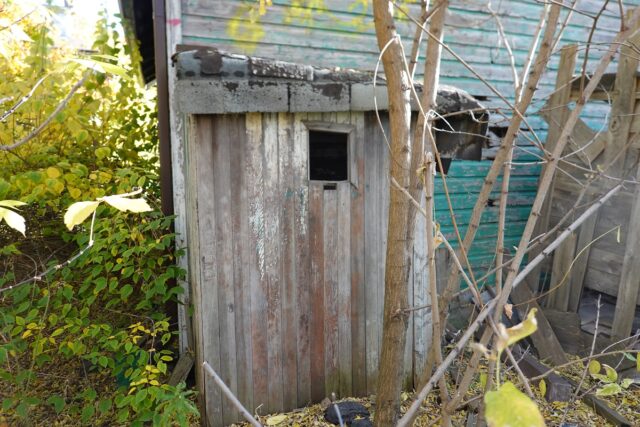
Val blurted out, “holy shit, that’s my bike!”
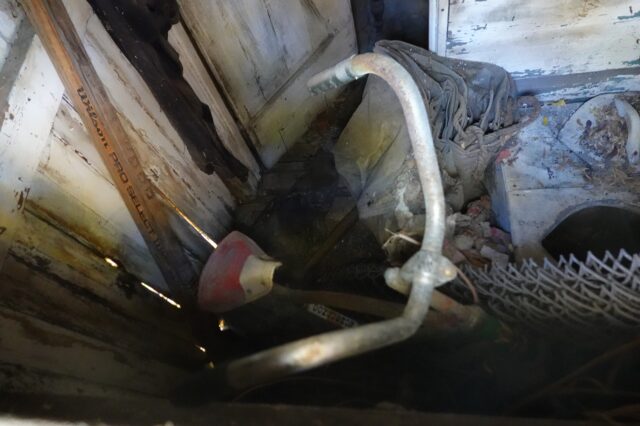
I’ll let you in on a little secret. This isn’t just some random house we visited on a lark. When Val was small he used to go to this house to visit his step-father’s parents. The last time he ever saw this bike was there in that barn, which, by the way, also housed a pigeon coop and a whole lot of other “stuff.” He thinks he last visited there somewhere around 1980.
It felt like archaeology crossed with Halloween. And just a side note particular to us, the bricks on the house are in great shape compared to our house built in the late 1980s. Val says the house probably dates back to at least the 1920s because the stove was hand-cranked.
We plan to research the house more. The lot has most likely been purchased by the neighbouring wax factory owned by The International Group. The factory dates to 1945, so the house is probably much older. Val thinks it was the area’s original farmhouse. We’ll see.
21
“21 Lessons for the 21st Century” by Yuval Noah Harari, published in 2018, offers an interesting take on the current world even though it was written pre-pandemic. It’s supposed to be about the future but I don’t take it that way since we are living in the future according to when the book was written.
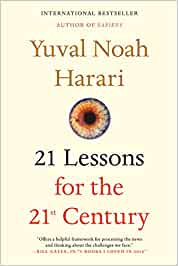
I don’t want anyone to think this is a self-help book, or one of those Jordan Peterson type guides to understanding the world. I don’t read such things. It’s a very thoughtful book written by a left-leaning history professor/public intellectual (a catchall term if ever there were one) with a deep interest in the effect of living in such a changing, global world. As for its purpose, I still can’t discern that even after finishing it. Not necessarily a bad thing.
Sometimes when you live in a fishbowl (the world) you have a hard time seeing the water. This means you don’t realize what’s around you on a daily basis. I feel that Harari’s role is to make the fishbowl visible. He describes the world as incredibly complex and constantly changing. He is critical, sarcastic, blunt. Sometimes he goes on weird tangents, as in the last bit of the book where he goes on about meditation. It was above my head, for sure. But there were a lot of chapters I thoroughly enjoyed, such as his critiques of religion (a human invention) and nationalism (another story humans tell themselves to simplify the world through focus on their country’s excellence.)
I particularly enjoyed the chapter on secularism. As an atheist (a term he did not use), I was curious to see what he’d say about secularism. Not that I don’t know the definition of the word – it’s actually one of the driving concepts in my unphilosophical life. Rather, I wanted to know what his critique would be. Harari (who I’d assume is a secularist) identifies the main preoccupations of secularism as ‘commitment to the truth’, lack of obsession with “any group, person, or book as if it and it alone has sole custody of the truth”, ‘compassion’, ‘equality’. ‘freedom’, ability to doubt and admit ignorance, and finally ‘responsibility’ – that humans care about what is wrong and want to make it better, actively, without invoking some kind of deity. Ironically, his criticism of these ideals is that they’re too idealistic for the needs of the world and can default into the creation of emotion-based stories rather than realities, like any other movement. He calls this the ‘shadow’ of secularism. I will take one for the team and accept that fault.
My favourite quote from the book might be my hook for grade 12 history class this coming school year: “Human stupidity is one of the most important forces in history, yet we often tend to discount it.” This pearl of wisdom comes in the chapter on war. He follows it up with “…even rational leaders frequently end up doing very stupid things.” I love it! So true. And hard to convey in history class when students want to understand why people do things.
For the Careers class I must teach this coming year, I will refer to the chapter entitled “Education” in the part of the book called, interestingly, “Resilience.” Here his premise is that the world is changing so quickly we teachers won’t even know what our students’ futures will be like. I often think about the paradox of me teaching careers class; I’ve been in the same career for 24 years, overridingly at the same workplace, too. Here’s a relevant passage: “In such a [information saturated] world, the last thing a teacher needs to give her pupils is more information. They already have far too much of it. Instead, people need the ability to make sense of information, to tell the difference between what is important and what is unimportant, and above all to combine many bits of information into a broad picture of the world.” I sincerely hope that is what I do, or at least try to do, as a teacher. Later in the chapter he thinks “schools should downplay technical skills and emphasize general-purpose life skills. Most important of all will be the ability to deal with change, learn new things, and preserve your mental balance in unfamiliar situations. In order to keep up with the world of 2050, you will need not merely to invent new ideas and products but above all to reinvent yourself again and again.”
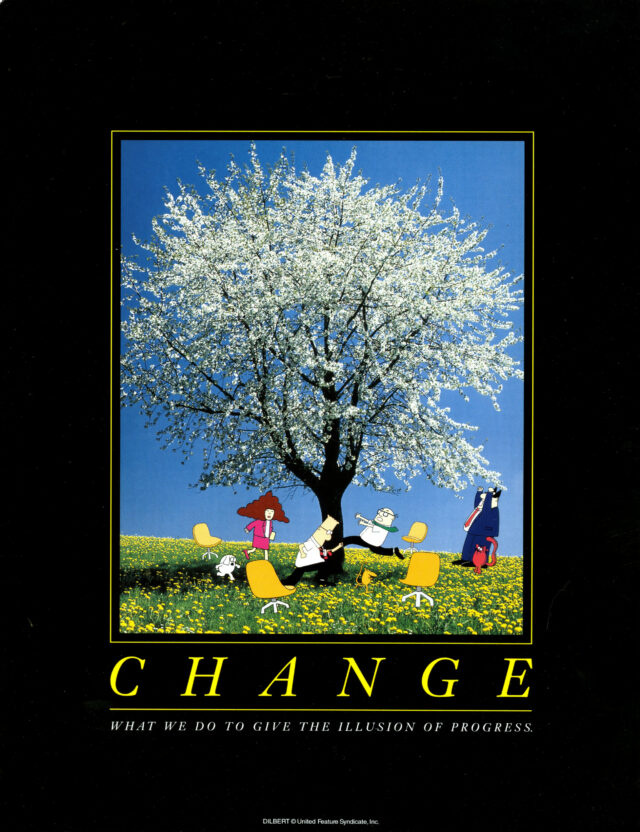
Me teaching the inventing part? I’m not sure about that, but I can definitely help with the life skills part. I don’t hate the Careers curriculum, and it overlaps a lot with the GLS (learning strategies) curriculum that is one of my mainstays in student success. We’ll see how I do offering guidance for the future.
On the whole “21” is a really interesting read with a few weird bits about science fiction and meditation thrown in. It proves to me that the pandemic is not adding new problems to society; it’s just elaborating on ones we already faced. Sadly, we’re not getting better at coming up with long-term solutions.
Next up? I may check out one of Val’s previous recommendations, “Thinking Fast and Slow” by Daniel Kahneman.
A Tiny Provincial Park
Mark S. Burnham in Douro, just outside Peterborough, is the smallest provincial park I’ve ever seen (not that I’ve seen that many). It has no staff, just paid parking.
We went on a very hot day and were met with a very cool forest. Unfortunately, the trail was blocked off at a certain point as they are still cleaning up from the wind storm in May. It feels pretentious to call it ‘derecho’ but I will.

At the entrance it says that the land was owned by the Burnham family who never cleared their land. Therefore, what you see is what the land might have looked like over a hundred years ago, probably more. The sign also says to look up as some trees have their ages on them from sometime before 1975. I’m guessing that’s when the land passed to the province? We only saw one such sign near the entrance to the trail. When I started taking pictures I didn’t notice that I had the camera set to “illustrated” mode. So here’s a kind of funny take on that tree. And then the actual sign.
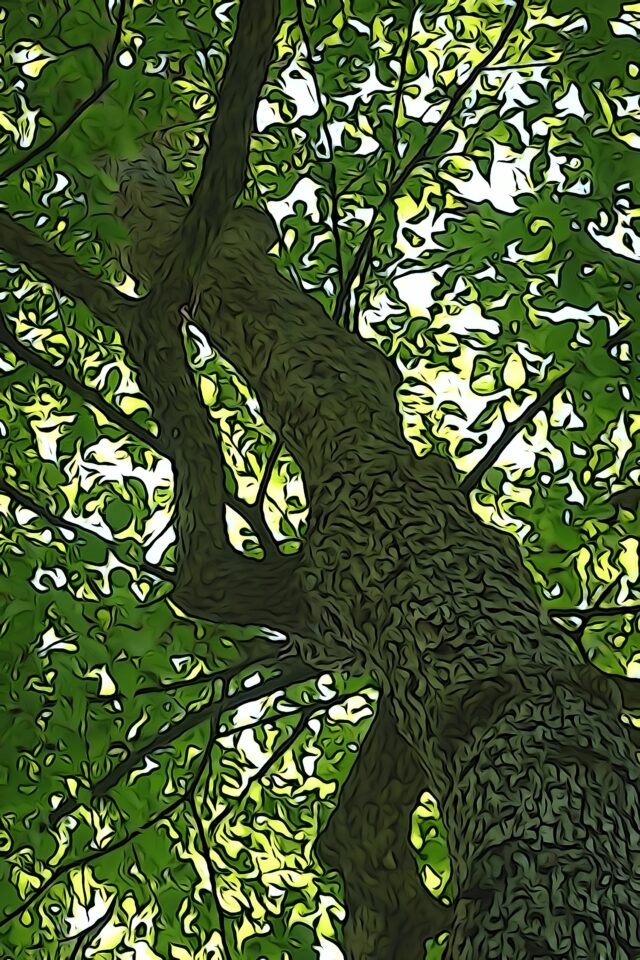
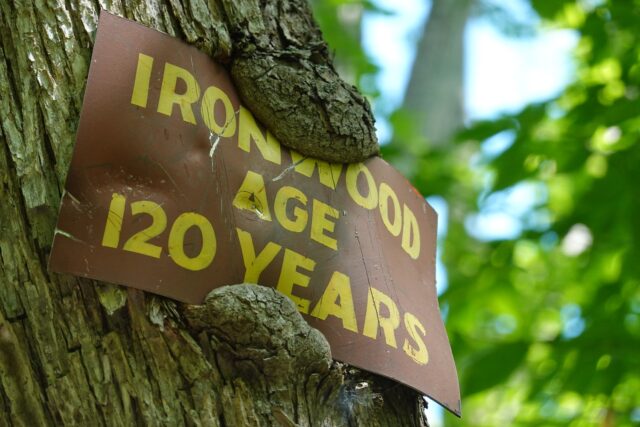
Actually, the land came to be a provincial park in the 1950s. Here’s what its management plan says about its history: “This land was donated to the Province of Ontario in the1950’s, by the descendants of the Honourable Zaccheus Burnham, a judge from the Town of Cobourg, who originally acquired the land in the 1830’s. From the 1830’s to present day, the woodlot has not been substantially disturbed, except for the removal of fuelwood for the needs of the Burnham family.” (Source)
Even though the park is just off Highway 7 with quite a lot of passing traffic, including lots of trucks, I didn’t mind the sound: reminds me of walking in the Don Valley where you are usually not far from the DVP. It does not take away from the experience of nature, in my opinion.
There are a lot of trees down in this park, and a lot of signs down, too. So I don’t know what the signs said. The one sign still readable was at the start and it said to watch for woodpeckers. I didn’t see any but here’s some evidence that they’re present!
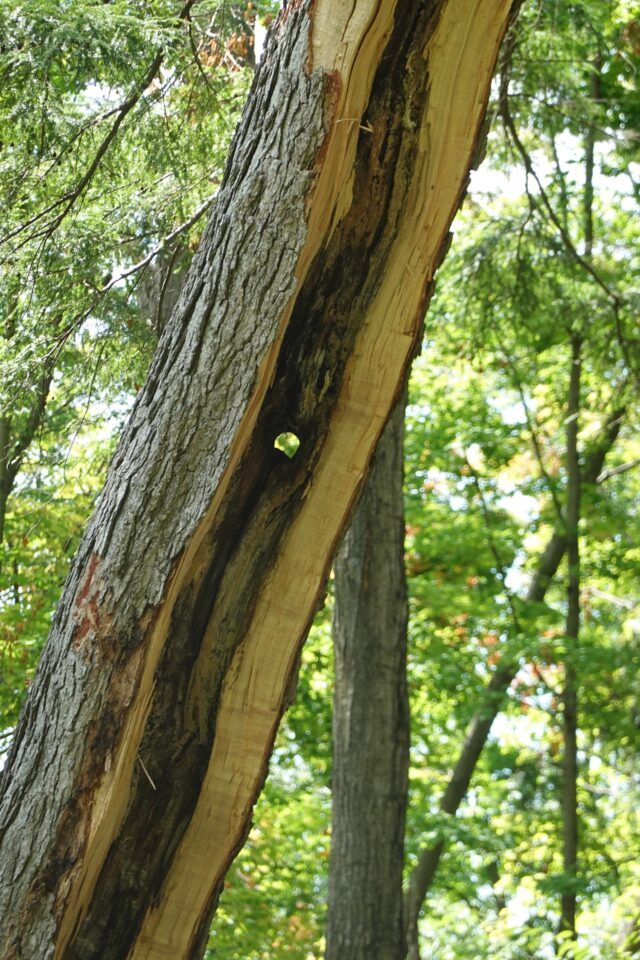
It’s a lovely small park, very accessible. I look forward to going back when the trails are cleared.

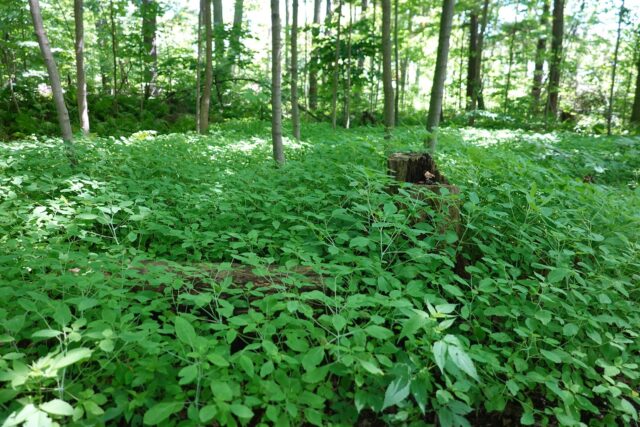

After visiting Mark S. Burnham we drove around in Peterborough, including on Ashburnham and Burnham. I must look into these Burnhams more. One funny thing: the locals apparently call the park Burnham Woods. That’s a nice little play on Birnam Wood in Macbeth. I don’t know if that’s intentional, or not.
Two Books: Metal and Marrow
Charlie Angus’s book, Cobalt, went everywhere with me – backyard, streetcar, subway, doctor’s waiting room, cottage – because it’s highly readable and really well done. I zipped through it even though it’s a depressing topic. Initially I picked Cobalt for two reasons: one, I heard Charlie Angus speak many years ago and found him to be very insightful; two, one of my family members was born in Cobalt and it is part of family lore of the “northland.” Of Ontario, that is.
Cobalt is the story of exploitation of northern Ontario. It starts not with the mining of the precious and elusive metal, but with internal colonization of the north of the province for the purpose of what all mother countries want – extraction of resources. And that meant, consistent with the rest of Canada’s history, disempowerment of the Indigenous people who were there. They lost their land and their rights to its riches.
Next came the exploitation of the workers who mined the silver for the benefit of large corporate interests. Cobalt was a boom town in the early 1900s. Like most, it saw its share of highs and lows, but the town is still there. It’s a real, thriving town, not a ghost town. That I like about Charlie Angus’s attitude toward the town where he lives. He details the ins and outs and who’s who of corporate control that essentially built the Toronto stock exchange, while he details the absolute mess they made of the town site. Poisoned water, no infrastructure, garbage everywhere. The Ontario government just didn’t want to pay and it didn’t want to force rules on precious corporations. Sound familiar? Eerily so.
Cobalt attracted a multicultural workforce from the start, and that’s where my family’s history comes in. While experienced American miners made their way there, so did Poles, Ukrainians, Finns (that’s Val’s family history), and Jews. From what I know, my family came from a small town (a shtetl, probably) in Belarus called Bichov. I may be mixing up different sides of my mom’s family, but suffice to say that they came from the former Russian empire. They set themselves up following the extension of the railroad in northern Ontario and sold supplies to local miners and lumberjacks. Eventually they settled in South Porcupine and then Timmins setting up a store and provisioning business. Timmins and Porcupine feature prominently in the book as the mining boom travelled north for gold after it was finished with Cobalt.
Like that, Cobalt’s story mirrors the Canadian experience that all started with the total exploitation of Indigenous peoples. We are all colonization and its after-effects, sadly.
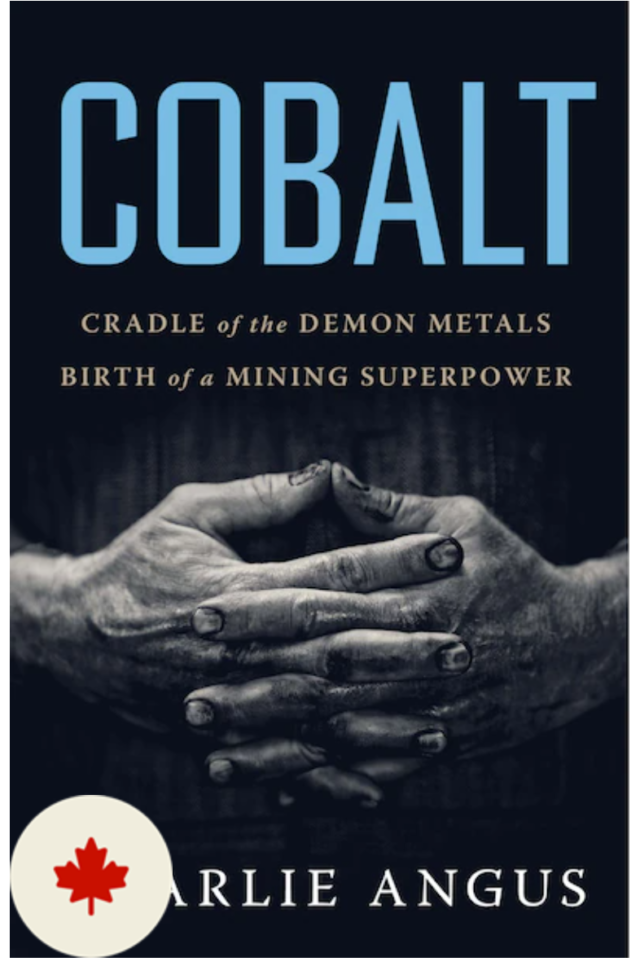
My next book imagined the dystopian future of a colonizing past. The Marrow Thieves by Cherie Dimaline was an excellent if highly disturbing book. Written for young adult readers, it picks up the story of Indigenous people in the future after some kind of climate disaster has rocked the world. People can no longer dream, except for Indigenous people, so they are hunted for their bone marrow which supposedly returns the power to dream. It’s basically residential schools the second time around except that that the inmates are all killed for their marrow.
I picked up this book in my school’s English department book room. In case I recover grade 9 or 10 English, I like to read a few of the books they use. So was the story with with Richard Wagamese’s Indian Horse. I found a lot of parallels with the The Marrow Thieves though they deal in different time periods. Both books were very tough to read but also very hard to put down. The protagonist in The Marrow Thieves, Frenchie, is a boy who has been on the run after losing his family. He finds a new ‘family’ with a group of fellow travelers who are trying to escape the recruiters who literally hunt Indigenous people. It’s really the story of people trying to hang on not only to their existence but to their culture. There are many scenes in which the elders astound the youngsters with their knowledge of their language. Sound familiar? After taking a quick look through some reviews of this book, I don’t understand why so many negative readers couldn’t see that. It’s not really about running or dystopia. Those are just frames.
It’s a nicely written book. I liked Dimaline’s style: simple yet poignant in a very to the point way. I think Indian Horse has more depth and detail to it (the setting and the characters), but I don’t really think they’re meant to be compared. They are complimentary. After finishing The Marrow Thieves, I started up another YA book I had picked up: A Very Large Expanse of Sea by Tahereh Mafi. It didn’t last long before I decided it was poorly written and I put it down. Every sentence was written as if a teenager was speaking it. I guess for some people that is the point of YA’s realistic appeal. For me, I may swear A LOT when I speak, but I don’t want to read it. I’d like to (if I’m going to read fiction, that is) read a more idealistic voice at least in terms of language.
I think a 14 or 15 year old kid could do a lot worse than read the prose and the subject matter in The Marrow Thieves. We all need to keep learning the true history of our country.
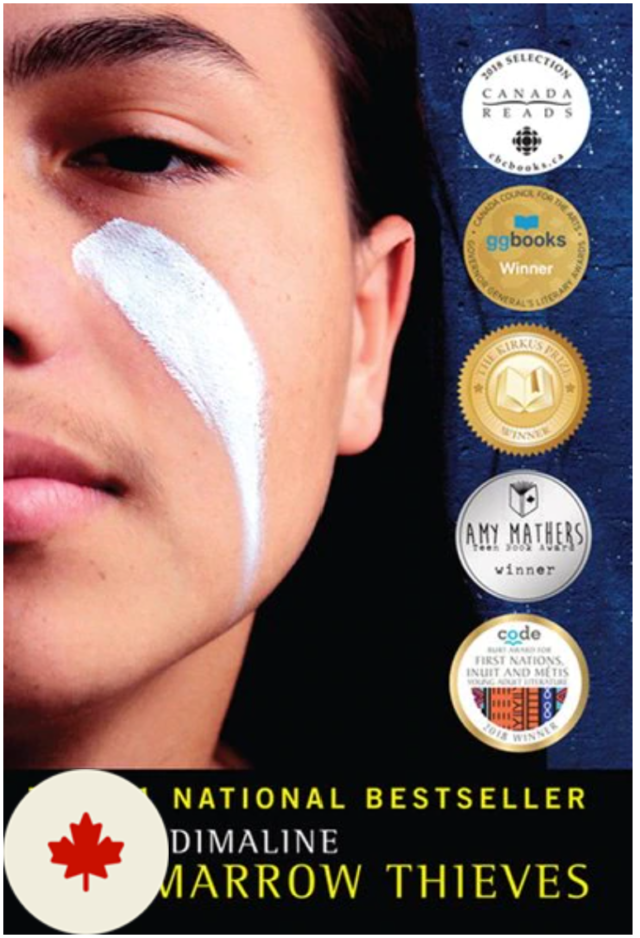
Next, I have returned to a book I put down about four years ago because I found it too negative: Yuval Noah Harari’s 21 Lessons for the 21st Century. Now, the pandemic makes the book seem more tame and less depressing so I’ll give it another try.
Grateful Reflections
Looking back, I now realize that a hospital is somewhat like a school and somewhat like a court. In other words, institutions have a lot of similarities.
I am very grateful for the excellent treatment I received at Michael Garron Hospital (MGH). Though my stay was brief (two nights), I feel I got some insight into how a ward worked, just as I tried to gain some insight into the court system when I nearly became a juror a few years ago.

Nurses are wranglers, like teachers. Their patients have to be corralled to take their medications and follow doctors’ orders. This is especially true at night. Even if they’re sleeping they have to submit to the same schedule of blood pressure and heart rate checks as during the day. Like teachers they must impose this care with the utmost kindness and efficiency. I was very lucky at MGH to have wonderful nurses who brought a sense of humour and compassion. Most of all, they listened.
Like a court, a post-operative hospital ward is full of mostly newbies (though there were definitely some repeat patients just as there were repeat potential jurors). There are a lot of signs and procedures. The most interesting procedural moment was when the entire gaggle in the pre-op waiting room moved together down the hall to the surgical waiting room. Val said it looked like a bunch of waggling ducks, all of us in our matching hospital gowns, socks and footcoverings. Thinking back, it was kind of similar to how we travelled as a group of 20 jury candidates as we moved in the not-often seen corridors behind the courtrooms at 361 University Avenue.
The court system doesn’t feed potential jurors. I wonder what they feed actual jurors??? I don’t want to sound offensive about the vegan food at MGH because the intentions were good. Execution was hit and miss: A palatable lentil soup but a slop of vegetable stew that I am sure contained meat; a passable chana masala with incredibly bland green beans and rice (though mixed together there was some seasoning there). I didn’t eat the first meal that was delivered as it wasn’t vegan. The PSW showed it to me and that was enough to make me turn off food for a day. The second delivery (vegetable chili) seemed okay but my appetite still hadn’t returned after seeing and smelling the hard-to-identify fish patty. Regardless, the meals were delivered in a timely and friendly manner. There were options, and the trays were picked up routinely. The humans behind the system are obviously working hard and doing their best to provide healthy options.
Nurses and teachers have family members of their “clients” in common. Just as teachers must keep in touch with parents, nurses must reach out to family members about visiting times (it is the covid era, after all), clothing items needed, missing medications, etc. Covid probably keeps this issue more at bay for nurses, though that is just an outside observation. Perhaps not having family members physically available means more chasing after phone calls and emails. As far as I saw when I was “auditioning” for jury duty, there was no familial connection at all, except for the fact you’re not supposed to discuss anything with anyone!!
One thing that is in demand in a hospital is a walking straight-away. By that I mean a long corridor uninterrupted by rabbit-warren-like offshoots (due to renovations and additions over the years). There was one such runway on the fifth floor of MGH that seemed to be used by patients of both units A5 and B5. It ultimately led to a small elevator area with a good overlook on the new construction. From there I could see the old buildings and their connections to the new building, the attempts to match brick colours, the courtyards, and the open spaces. It looked quite nice and I suppose its future completion is aspirational for patients hopping to get out of the joint! At that same end of the above-mentioned corridor was a seemingly unused back used doorway to the “end of life” care area, MGH’s palliative care ward, I suppose. I felt sad every time I went near that door, especially knowing that my stay would be brief.
So, like a school and like a court system, a hospital – though an institution – is at heart a place full of people.

